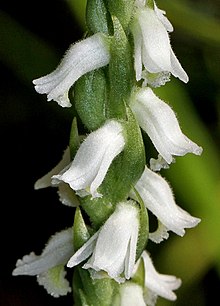| Panther ladies' tresses | |
|---|---|

| |
| Inflorescence | |
| Scientific classification | |
| Kingdom: | Plantae |
| Clade: | Tracheophytes |
| Clade: | Angiosperms |
| Clade: | Monocots |
| Order: | Asparagales |
| Family: | Orchidaceae |
| Subfamily: | Orchidoideae |
| Tribe: | Cranichideae |
| Genus: | Spiranthes |
| Species: | S. triloba |
| Binomial name | |
| Spiranthes triloba (Small) K. Schum. | |
| Synonyms | |
| |
Spiranthes triloba, the panther ladies' tresses (previously sometimes green-lipped Spiranthes odorata) is a terrestrial orchid endemic to Florida.
Description
Spiranthes triloba plants have up to 5 basal leaves that can sometimes be wilted by the time they are flowering. The flowers are white and fragrant and arranged in a spiral around the stem. The lip of each flower is green for newly opened flowers and changes to yellow over time. Bloom time is during winter, from October to February.
They look similar to Spiranthes odorata and Spiranthes cernua but the lip changing in color from green to yellow clearly distinguishes them from either. In fact locals in Florida long knew that there were Spiranthes odorata plants with this difference in appearance and called them green-lipped Spiranthes odorata.
The common name panther ladies' tresses is an homage to the Florida panther which is also endemic to Florida and lives in the same habitat as these flowers.
Distribution and habitat
Spiranthes triloba is endemic to Florida and prefers frequently burned prairies. This habitat is distinct from that of Spiranthes odorata which prefers flooded forests.
Taxonomy
The Spiranthes triloba plants were first described by John Kunkel Small in 1898 as Gyrostachys triloba and transferred to Spiranthes triloba by Karl Moritz Schumann in the same year. However, for the next 118 years Spiranthes triloba was rarely considered a separate species and included as a variation of Spiranthes cernua or Spiranthes odorata (which itself was often considered a variation of Spiranthes cernua). M. C. Pace conducted a phylogenetic and morphological study in 2016 and reinstantiated it as a separate species under Schumann's original name.
References
- ^ "Spiranthes triloba". North American Orchid Conservation Center (NAOOC), Smithsonian Environmental Research Center. 2018. Retrieved 19 February 2022.
- ^ Pace, Matthew C.; Cameron, Kenneth M. (2016). "Reinstatement, Redescription, and Emending of Spiranthes Triloba (Orchidaceae): Solving a 118 Year Old Cryptic Puzzle". Systematic Botany. 41 (4): 924–939. doi:10.1600/036364416X694026. JSTOR 44821389. S2CID 90359676. Retrieved 15 March 2022.
- "Spiranthes triloba". Plants of the World Online. Royal Botanic Gardens, Kew. Retrieved 3 March 2022.
![]() Media related to Spiranthes triloba at Wikimedia Commons
Media related to Spiranthes triloba at Wikimedia Commons
| Taxon identifiers | |
|---|---|
| Spiranthes triloba | |
| Gyrostachys triloba | |